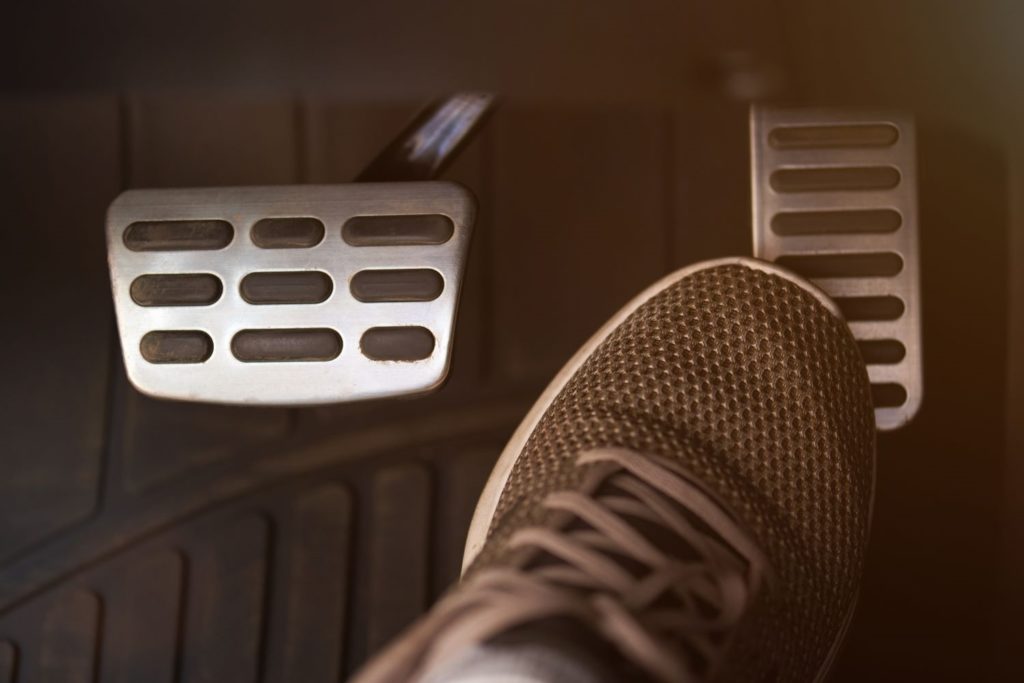The function of the throttle and brake pedals is straightforward. The throttle pedal accelerates the vehicle when you press on it, while the brake pedal activates the brakes and slows the vehicle down. They might appear similar but they actually have distinct characteristics that differentiate them from one another.
The size of the pedals can vary depending on the vehicle model. In terms of appearance, the throttle pedal can be taller so that it can fit your entire foot’s arch. The throttle pedal is quite sensitive and small inputs can result in drastic changes in your engine’s revolutions per minute (RPM), especially when your clutch is disengaged. The brake pedal can be much shorter in height, but wider in width. Shaping the brake pedal like this can make the brake pedal easier to find after coming from the throttle pedal since it’s common practice to use the right foot for both the throttle and the brake. Depending on the vehicle model, pedals can also either be hanging or mounted to your vehicle’s floor.

Throttle and Brake Pedal Positions
The throttle pedal is always the rightmost pedal, while the brake pedal is on the immediate left of the throttle pedal. The throttle and brake pedals are also at different heights. The brake pedal sits noticeably higher compared to the throttle pedal. This can help the driver identify the pedal just through feel alone. Unlike the throttle pedal, which is much more sensitive, the brake pedal requires more pressure in order to slow the vehicle down. The added height can make it easier for drivers to press on the pedal since their legs will be bent. A bent leg allows them to push down on the pedal easier.

How Does the Throttle Pedal Work?
The throttle pedal controls the amount of air and fuel that enters the engine’s intake. The throttle pedal is typically connected to the engine’s throttle body through a wire. When the pedal is pressed, the wire will open the throttle body, allowing more air to enter the engine. There’s also a throttle position sensor located in the throttle body. This sensor measures the driver’s throttle inputs and sends them to the powertrain control module (PCM). The PCM makes various changes to the air-fuel mixture and ignition timing to allow the engine to meet the driver’s power demands.

How Does the Brake Pedal Work?
When you push the brake pedal, it will depress a piston in the master cylinder. The brake master cylinder will force fluid along hydraulic lines into slave cylinders located at the wheels. As the slave cylinders are filled, pistons will push the brake calipers into the brake rotor, effectively creating friction and slowing the vehicle down. The braking system is designed to evenly distribute fluid pressure to ensure braking is uniform across all four wheels.
Getting New Brake and Accelerator Pedals for Your Vehicle
You can’t drive with a broken accelerator pedal or a damaged brake pedal. Even if your engine can still run, you won’t be able to control your vehicle. Accelerating becomes hard to control, and your brakes are likely to fail. For your own safety, you should replace your broken pedal as soon as possible. Thankfully, getting replacement pedals is fast and easy with CarParts.com.
CarParts.com offers a wide selection of brake and throttle pedals that are sourced from the most trusted manufacturers in the industry. You can easily browse through our catalog with the help of our vehicle selector and search filters. All you have to do is enter your vehicle’s details, and you’ll see all the available parts that are compatible with your ride. If you’re itching to get back on the road, you’ll be pleased to know that CarParts.com also guarantees fast shipping. Order by 12 PM ET, and your package should arrive in as fast as two business days.
Don’t wait until your pedal completely breaks before replacing it. Check out our catalog of high-quality brake and accelerator pedals at CarParts.com and order today!
Any information provided on this Website is for informational purposes only and is not intended to replace consultation with a professional mechanic. The accuracy and timeliness of the information may change from the time of publication.






























